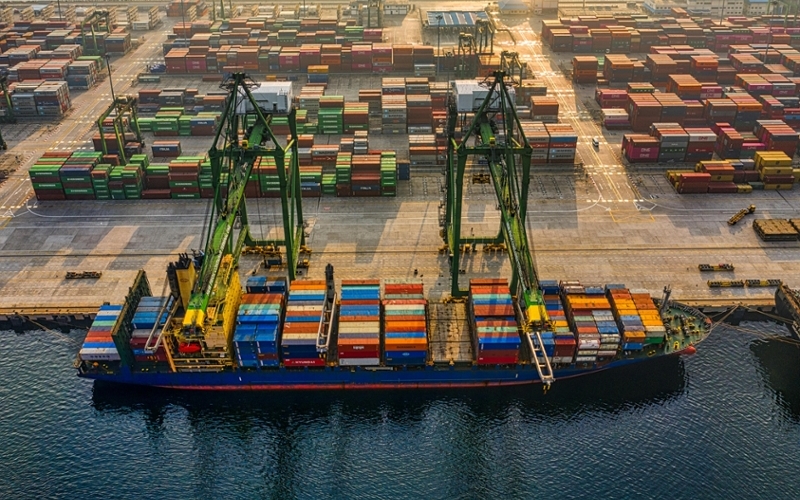
Navigating the Fog of Trump’s Trade War
The global economy is facing major instability, especially due to the Trump administration’s trade policies, which have permanently disrupted free trade with the U.S. and the global trading system. Canada must act quickly with bold policy changes to stay competitive and find new export markets.
By Kevin Lynch, former federal Deputy Minister of Finance, Clerk of the Privy Council and Canadian Executive Director of the International Monetary FundIntroduction
Download the Discussion Questions
We are in a global crisis, once again. This time the cause is neither a globe-hopping virulent virus nor a flood of subprime American mortgages but an attack on the global trading system by the U.S. President. Donald Trump’s trade war may be the ultimate “black swan” event – a crisis which epitomizes uncertainty and creates chaos.
Where this trade war ultimately takes us is unknowable at this moment, but what is clear is that the postwar global system of liberalized trade and rules-based international commerce has been demolished at the whim of the President. A system built over 70 years was left in tatters in less than 70 minutes by President Trump as he launched his global tariff attack in a shameful Rose Garden spectacle.
American punitive tariffs are only the opening chapter of this global tragedy.
Shortly we will begin to know more about how the global economy responds to these tariffs, their impacts on prices and costs and supply chains, and the uncertainty they have caused for firms, workers, consumers and investors. The chaos unleashed by Trump’s “Liberation Day” tariffs in all likelihood means we are headed towards stalled growth if not an outright recession in North America by the second half of this year and a sharp downturn in global growth.
Beyond this, how other countries respond, both with respect to retaliatory trade measures and more importantly with structural policy changes, will crucially shape the future trajectory of this crisis. So too will how firms and investors respond to the uncertainty about future tariff policy in the U.S. And then there is the trust factor: how will the loss of trust in the United States affect global economic and security alliances going forward.
Will this push Western nations to seek new trade arrangements that do not include the United States? Will the U.S. dollar lose its supremacy as the world’s reserve currency? Will it, combined with Trump’s ambivalence to NATO and abandonment of Ukraine, be the impetus to form new Western security partnerships without a U.S. backstop? Will China use this loss of trust and confidence in American policy, and its own economic and military might, to create a much tighter sphere of geopolitical influence throughout Asia? And, what might Russian President Vladimir Putin, who is gleefully following Trump’s economic, security and geopolitical missteps, decide he can now do with impunity in Eastern Europe and the Arctic?
As Canadian policy makers and business leaders consider in the weeks and months ahead how to respond to Trump’s trade war, the most important takeaway is that this is a permanent structural shock – we no longer have the certainty of free trade with the United States regardless of whether we have a signed trade agreement or not. At the same time and for similar reasons, the postwar, rules-based, global trading system is no more. Canada has to respond rapidly and forcefully with major policy changes to rebuild our competitiveness, productivity and growth while finding new markets for the portion of our exports which may no longer go to the United States. Transition supports must be just that – to a new market reality not a bridge to the past. There is no turning back – if the U.S. can elect one Donald Trump and what he stands for, it can elect another, and we have to plan on that basis.
Crisis management usually begins by establishing a clear understanding of the causes of the crisis and yet, today, there is a total absence of clarity about what Trump is actually trying to achieve. His statements are mutually contradictory, lacking in strategic reasoning and rooted more in “gut instinct”, to quote Mr. Trump himself, than in economic logic.
Examples of this muddled thinking abound. Some days Trump’s tariffs are presented as a new and permanent source of revenue, paid for by foreigners, to fund American tax cuts and reduce the U.S. deficit. The problem with this logic is that tariffs are effectively a national consumption tax which will raise American prices and costs and disproportionally hurt middle income Americans.
On other days, Trump claims his tariffs will force companies to bring manufacturing production and jobs back to the United States. The problem here is twofold: uncertainty he has created about who the tariffs apply to and how long they will last undermine the incentive for firms to make the expensive, long-term investments necessary to shift production to America from other locations. In any event, America is a high-cost manufacturing location with a skilled labour shortage, so whatever manufacturing production is moved back to the United States will be highly sophisticated and highly automated, creating few new manufacturing jobs. Despite Trump regularly pointing to tariffs as the salvation to America’s large trade deficit and wanting to do country-by-country “reciprocity” deals to eliminate bilateral trade deficits, the reality of the U.S. trade imbalance is less about nefarious foreign trade barriers and more about too much American demand, too few American savings and too large a government deficit. As a result, other countries supply the goods Americans want and at low prices and take American debt in return.
One tariff rationale that Trump shares with the Biden Administration is that the U.S. is in an existential strategic competition with China and tariffs are part of the toolkit to constrain China’s dumping of manufactured goods into American markets and their access to advanced technologies. If this is the primary objective, why place tariffs on the rest of the world, and particularly on allies and free trade partners like Canada and Mexico, whose cooperation you need in a strategic competition with China in today’s hyper-connected global marketplace? The reality is the global trade war Trump initiated will only reduce U.S. economic power and erode its international political influence, allowing China, with its economic heft and strategic capacity, to work around the United States and further its geopolitical goals.
The Wall Street Journal had it right: this is indeed the dumbest tariff war in history. The verdict of equity and bond markets has been even more brutal.
The question we need to ask ourselves is, faced with a rogue neighbour and a dramatically changing world, how should Canadians view the future and what can we do? Five key considerations and priorities come to mind.
What we should be willing to offer in any negotiation are things that are in our national interest. These include: raising spending on defence to the NATO target of 2% and likely above; spending more on border security to impede the movement of drugs and illegal migrants; committing to a greater defence and security capacity and presence in the Arctic; increasing the existing (and underused) tariff free milk quota; and a tighter rules-of-origin regime to avoid dumping by China. The U.S. will demand the elimination of the Digital Sales Tax. What we should insist on getting is greater “certainty” in any agreement, an elimination of all American tariffs on steel, aluminum and autos, and a workable softwood lumber regime. What we should avoid is any American rights-of-access to Canadian freshwater and to Canadian government procurement (federal, provincial and municipal).
Facts matter in trade negotiations. Trump and Americans have to be reminded that the U.S. goods trade deficit in 2024 with Canada was $70.6 billion USD (using U.S. government data) while the U.S. had a surplus with Canada of $34.9 billion USD in services for a total trade deficit with Canada of $35.7 billion USD. For context, that deficit amounts to a miniscule 0.001% of U.S. GDP, and the surplus is entirely accounted for by American demand for Canadian crude oil which it buys at a sizeable discount to the world price, benefitting Americans and costing Canadians.
Second, we need stronger economic growth. What this requires is a laser focus on a few, top-priority, growth-enhancing initiatives and an equal focus on speed to delivery. It is great to talk about east-west pipelines but the timeframe for gas to ship to Europe is likely well over a decade. We need more growth now. So, in the spirit of speed, the priority initially should be on more pipelines and LNG facilities on the west coast to serve Asia. Similarly, new trade corridors are clearly needed but the first priority has to be finding new markets outside North America for the portion of our exports currently going to the United States that tariffs or the threat of tariffs put at risk. Again, with an emphasis on speed, we should shift from launching new free trade agreements, which take a very long time, to negotiating sector specific trade arrangements – oil, gas, potash, and agricultural products are potential examples -- with countries in Asia, Europe and South America that are willing to commit to long term off-take agreements.
One market within our control is internal trade, and if ever there was a time to tear down local barriers in the national interest it is now. Governments should implement Canada-wide reciprocity agreements across provinces and territories to eliminate the majority of internal trade barriers this year.
Equally important is an early boost to private sector productivity and competitiveness. Part of this is tax incentives for corporate investment, part is incentives for innovation and entrepreneurship, and a big part is reducing the regulatory burden that constrains the ability of firms to build things. When it takes more than 16 years to open a mine, we make ourselves irrelevant as a global player in critical minerals which are key to advanced manufacturing in the future. These same regulatory hurdles will bedevil speed to delivery for trade corridors and further lessen the attractiveness of Canada for foreign investment. The government must be willing to fundamentally reform the regulatory system to meet the challenges of these times.
One untapped opportunity is to use government procurement more strategically to purchase the products and services of innovative Canadian start-ups and by so doing enable them to ramp up to exporting to global markets.
For example, Canada is a world leader in Artificial Intelligence (AI) research but largely non-existent in commercial applications of AI which will be a dominant feature of business (and government) efficiency and productivity in the future. Another example is the dominance of American cloud computing services in the Canadian marketplace including government and business while there is no obvious Canadian provider, notwithstanding our ready sources of power, capital and talent. The best example is a complete rethink of military procurement. As Canada ramps up its spending –in the tens of billions of additional dollars -- to meet (and likely exceed) our NATO defence spending commitments over the next two or three years, continuing to buy our major military tech gear from the U.S. makes no strategic, security or economic sense in Trump world. Rather, we should be looking at new partnerships with European defence contractors to develop and build advanced dual use technologies here in Canada. This could also be a building block towards new security partnerships in Europe and elsewhere.
Third, balance sheets matter. We have to make fiscal policy a comparative advantage again in a world racked by uncertainty and volatility. In recent years we have squandered our hard-earned fiscal advantage with massive increases in spending and debt. In 2024, the federal deficit will likely be in the $50-$55 billion range with the elimination of the capital gains tax increase and the payment of the carbon tax rebate after the tax was cancelled -- well above the 2024 Budget estimate of roughly $40 billion.
For 2025, the combination of an already high starting deficit, a number of expensive campaign promises, the costs of ramping up military spending to meet the NATO target sooner rather than later, and the impact on revenues of worsening economic growth due to the Trump tariffs (a 1% drop in real GDP growth increases the deficit by $5 billion) all suggest a rising deficit unless actions are taken to rein in spending. The net debt-to GDP ratio is also rising, not falling, and is likely in the neighbourhood of 45% of GDP in 2025. And the gross debt-to-GDP ratio, which deserves more attention given the growing gap between the fiscal deficits and financial requirements, will be near 70%. This all calls into question whether the policy proposals of the major parties are affordable given the state of our fiscal books. It raises the issue of what magnitude and type of program and personnel cuts are needed to rein in deficits, and if a future government might have to revisit the Harper-era GST cuts to responsibly finance increases in defence spending and health care.
With the global trade war broiling, with the world economy possibly entering a downturn and with a U.S deficit over 7% of GDP spewing red ink and driving the U.S. debt-to-GDP ratio over 120%, global financial markets are jittery and prone to large and sudden swings. The bond vigilantes are circling U.S. debt and currency markets. Just as it was the case in the 2008-09 financial crisis, having the best balance sheet in the neighbourhood provides a buffer against shocks and speculation, and keeps Canadian bond premia relatively low, helping businesses.
Fourth, expect more tariff surprises from President Trump. We have to be ready with further retaliation if an unpredictable Trump imposes new tariffs or unveils new threats. As the government has done so far, the retaliation should be proportionate and done with a maximum of impact but a minimum of rhetoric.
What the government could consider, in any future response, is placing taxes or other restrictions on American service exports to Canada since the U.S. runs a massive trade surplus with us. This could be as targeted as Starlink, or cloud computing services from Amazon and Microsoft, or streaming services from Netflix, Apple, Disney and Amazon, or social media advertising revenues from Meta or Google. We should also consider export taxes on exports to the U.S. that have inelastic demand and few near term substitutes. One example could be an export tax on oil exports to the U.S. equal to the discount on Canadian heavy oil, with all the tax proceeds being returned to the affected firms and provinces. Potash is another possibility given the enormous U.S. reliance on Canadian supplies.
Fifth, who are our friends going forward? Not a question many would have asked a year ago, but a burning issue today. Trust has been broken with the United States and our relationship will become more transactional. What about Europe? This is a question they are also asking themselves, but if they pull together not apart, we should seek ways to deepen our economic and security connections. The U.K has been a fair-weather friend of late, hoping for a special relationship with Trump’s America, so time will tell where their interests align. Like Canada, Japan and South Korea have been traumatised by the Trump trade war and have very complementary economies to our own. India is an interesting possibility if we can resolve their unhelpful tendencies towards foreign interference. And what about South America, which will now be courted even more assiduously by China, and our CUSMA partner, Mexico? At this point, the question is clearer than the answer.
The new government elected on April 28, 2025, will be called upon to steer Canada through a global tariff war initiated by the United States, a restructuring of the global order of a magnitude not seen in generations, and a fragile Canadian economy beset with American tariffs, anemic productivity and weak competitiveness. A massive challenge and a great responsibility.
Canada cannot afford a business-as-usual agenda in a world turned upside down. An unexpected asset for the new government to tap into is the amazing outpouring of patriotism from coast-to-coast in response to Trump’s denigrating comments on annexing Canada. This patriotism, and the accompanying public desire to do what it takes for Canada to survive and ultimately thrive, is an opportunity to make big changes and do big things provided our leaders connect the dots and explain why the changes are in the national interest. As our former Prime Minister, Mackenzie King, said in very trying times years ago: “Adversity reveals the true character of a nation and its leaders.” These times certainly need steely leadership and a determined public. Elbows up, Canada.
Kevin Lynch

Kevin Lynch has been a leader in both the Canadian public and private sectors, and is a strong public advocate for sound economic and fiscal policies that enhance Canada’s productivity and competitiveness. Dr. Lynch was the 20th Clerk of the Privy Council, Secretary to the Cabinet and Head of the Public Service of Canada. His government career also included serving as the Deputy Minister of Finance, the Deputy Minister of Industry and the Executive Director for Canada at the International Monetary Fund.
Following his government service, Lynch served as Vice Chairman of BMO Financial Group from 2010–2020. At the same time, he was active in a number of influential international organizations including the World Economic Forum, the Organization for Economic Cooperation and Development (OECD), the Institute of International Finance, and the Bretton Woods Committee, among others. He has served on several public and private sector boards, including the Bank of Canada, CN Rail and CNOOC Ltd. and authored and co-authored over 250 policy Op Eds and opinion articles. Dr. Lynch earned a BA from Mount Allison University, a Masters in Economics from the University of Manchester and a doctorate in Economics from McMaster University.


